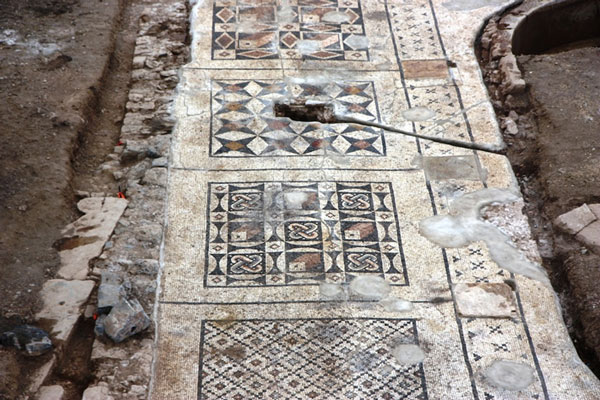Architectural mosaic in Roman Empire
A large swimming pool with complex geometric patterned mosaic was unearthed in southern Turkey, revealing the profound influence of the Roman Empire at its peak.

This mosaic is contiguous to a 7m long pool, according to Professor Michael Hoff of the University of Nebraska (USA), the date of the mosaic is about the 3rd or 4th century, surprisingly the size of the mosaic to 149m2.
According to LiveScience, the area was first discovered by Professor Nick Rauh of Purdue University (USA) in 2002 near the ancient city of Antioch Cragum, but had no funds to excavate. By 2011, when the license was obtained and funding was available, the Turkish Museum invited Professor Hoff and his colleagues to survey the area. Up to now, 40% of the mosaic has been exposed, according to Hoff, the floor is still in pristine condition.
The mosaic background is decorated with star-shaped, circular motifs . showing the city of Antioch ad Cragum greatly influenced by Romans. Antiochia ad Cragum was founded in the first century, and still preserves a number of Roman architectures including several bathrooms and marketplaces.
According to the plan, the research team will return to volunteer students to complete the excavation expected in June 2013. A wooden floor will be designed to cover the mosaic and then open to visitors.
- The rare ancient Roman mosaic of the 4th century was discovered in England
- Discovered mosaic paintings of 1,700 years old in Israel
- Unearthed 1,600-year-old Roman mosaic paintings
- Life of a citizen of the Roman Empire in ancient times: Every day must survive
- Discovered the unexpected cause of the collapse of the ancient Roman empire
- The most powerful Empire ever defeated the Roman Empire and ended after 'bullying' Russia
- This is what really created a glorious Roman empire
- Confused about the sexual assault, the tyranny of Roman times
- Horrifying revelations about the Eastern Roman Empire
- Roman city 2,000 years under construction site
- New hypothesis about the cause of the Roman empire collapsed
- The king built a great empire and ended 23 stabbing
 Discovered an ancient centipede fossil 99 million years old
Discovered an ancient centipede fossil 99 million years old Discovered bat-like dinosaurs in China
Discovered bat-like dinosaurs in China Discovered a 200-year-old bronze cannon of the coast
Discovered a 200-year-old bronze cannon of the coast Discover 305 million-year-old spider fossils
Discover 305 million-year-old spider fossils